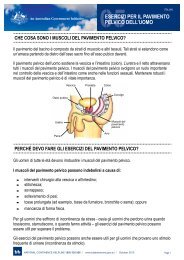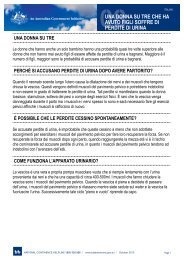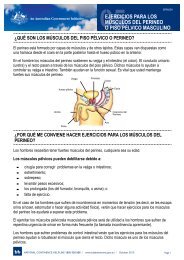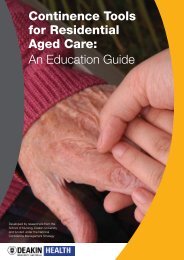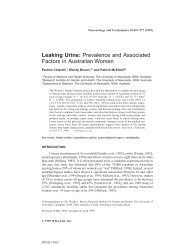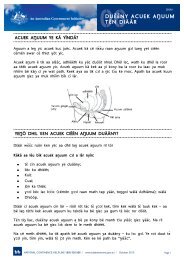Pharmacy Continence Care - Bladder and Bowel Website
Pharmacy Continence Care - Bladder and Bowel Website
Pharmacy Continence Care - Bladder and Bowel Website
Create successful ePaper yourself
Turn your PDF publications into a flip-book with our unique Google optimized e-Paper software.
Level of knowledge <strong>and</strong> level of confidence were indicated on a five-point scale where 5 is<br />
the highest <strong>and</strong> 1 is the lowest. Statistical analysis of all questions relating to level of<br />
knowledge <strong>and</strong> level of confidence showed a statistically significant shift towards a higher<br />
rating, post training, on all items. Figure 9 to Figure 21 illustrate this for questions 1-12 <strong>and</strong><br />
question 22.<br />
80%<br />
70%<br />
60%<br />
50%<br />
40%<br />
30%<br />
20%<br />
10%<br />
0%<br />
10.20%<br />
Q1. Rate your level of confidence in your knowledge of the anatomy <strong>and</strong> physiology of the urinary <strong>and</strong> gastrointestinal<br />
systems<br />
3.13%<br />
16.33%<br />
0.00%<br />
34.69%<br />
1 2 3 4 5<br />
Figure 9: <strong>Pharmacy</strong> responses to PIQ <strong>and</strong> PEQ Question 1 – knowledge of the anatomy<br />
<strong>and</strong> physiology of the urinary <strong>and</strong> gastrointestinal systems<br />
70%<br />
60%<br />
50%<br />
40%<br />
30%<br />
20%<br />
10%<br />
0%<br />
Q2. Rate your level of confidence in your knowledge of normal bladder<br />
<strong>and</strong> bowel function<br />
4.08%<br />
3.13%<br />
8.16%<br />
0.00%<br />
32.65%<br />
1 2 3 4 5<br />
Figure 10: <strong>Pharmacy</strong> responses to PIQ <strong>and</strong> PEQ Question 2 – knowledge of normal<br />
bladder <strong>and</strong> bowel function<br />
70%<br />
60%<br />
50%<br />
40%<br />
30%<br />
20%<br />
10%<br />
0%<br />
12.24%<br />
9.38%<br />
12.50%<br />
Q3. Rate your level of underst<strong>and</strong>ing of the different types of urinary<br />
incontinence?<br />
3.13%<br />
28.57%<br />
0.00%<br />
28.57%<br />
1 2 3 4 5<br />
Figure 11: <strong>Pharmacy</strong> responses to PIQ <strong>and</strong> PEQ Question 3 – underst<strong>and</strong>ing of the<br />
different types of urinary incontinence<br />
15.63%<br />
Final Report<br />
24<br />
NOVA Public Policy<br />
<strong>Pharmacy</strong> <strong>Continence</strong> <strong>Care</strong> Project<br />
34.69%<br />
51.02%<br />
26.53%<br />
18.75%<br />
65.63%<br />
59.38%<br />
4.08%<br />
4.08%<br />
4.08%<br />
18.75%<br />
21.88%<br />
68.75%<br />
PIQ<br />
PEQ<br />
PIQ<br />
PEQ<br />
PIQ<br />
PEQ



